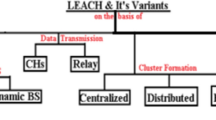Abstract
Wireless sensor networks are formed with very small sensor devices with limited energy and short transmission range. Sensors are randomly deployed in remote areas with harsh conditions. Due to this, their distribution are non-uniform. In a hostile environment, the occurring of large scale failure is very often and it creates partitions of different sizes in the network. Restoring the network connectivity is very crucial for network functioning. Typically sensors are static and communication is bi-directional and we need to reconnect the network with the additional relay sensor nodes. After reconnecting the network, overhead on relays is very high and thus it consumes more energy and high computational power. Optimal number of relay nodes required for reconnecting the network is an NP-hard problem. Here, we proposed a new heuristic approach called adaptive Cluster-based Relay Placement Algorithm. Our approach is to reconnecting the networks based on finding the nearest partitions using their centroids. Using the proposed algorithm, relays are placed on the denser part of the partitions and number of required relays are also minimum. It reduces the network recovery time and increases the network lifetime. Through simulation, we show that the proposed algorithm performs better than the existing approaches.











Similar content being viewed by others
References
Chouikhi, S., El Korbi, I., Ghamri-Doudane, Y., & Saidane, L. A. (2017). Centralized connectivity restoration in multichannel wireless sensor networks. Journal of Network and Computer Applications, 83, 111–123.
Nikolov, M., & Haas, Z. J. (2016). Relay placement in wireless networks: Minimizing communication cost. IEEE Transactions on Wireless Communications, 15(5), 3587–3602.
Akkaya, K., Senel, F., Thimmapuram, A., & Uludag, S. (2010). Distributed recovery from network partitioning in movable sensor/actor networks via controlled mobility. IEEE Transactions on Computers, 59(2), 258–271.
Lee, S., & Younis, M. (2010). Recovery from multiple simultaneous failures in wireless sensor networks using minimum steiner tree. Journal of Parallel and Distributed Computing, 70(5), 525–536.
Imran, M., Younis, M., Said, A. M., & Hasbullah, H. (2010). Partitioning detection and connectivity restoration algorithm for wireless sensor and actor networks. In 2010 IEEE/IFIP international conference on embedded and ubiquitous computing (pp. 200–207). IEEE.
Senel, F., & Younis, M. (2011). Relay node placement in structurally damaged wireless sensor networks via triangular steiner tree approximation. Computer Communications, 34(16), 1932–1941.
Lee, S., Younis, M., & Lee, M. (2015). Connectivity restoration in a partitioned wireless sensor network with assured fault tolerance. Ad Hoc Networks, 24, 1–19.
Lalouani, W., Younis, M., & Badache, N. (2017). Optimized repair of a partitioned network topology. Computer Networks, 128, 63–77.
Lee, S., & Younis, M. (2010). Optimized relay placement to federate segments in wireless sensor networks. IEEE Journal on Selected Areas in Communications, 28(5), 742–752.
Senel, F., Younis, M. F., & Akkaya, K. (2011). Bio-inspired relay node placement heuristics for repairing damaged wireless sensor networks. IEEE Transactions on Vehicular Technology, 60(4), 1835–1848.
Lee, S., Younis, M., & Lee, M. (2016). Optimized bi-connected federation of multiple sensor network segments. Ad Hoc Networks, 38, 1–18.
Han, X., Cao, X., Lloyd, E. L., & Shen, C.-C. (2010). Fault-tolerant relay node placement in heterogeneous wireless sensor networks. IEEE Transactions on Mobile Computing, 9(5), 643–656.
Hwang, S.-F., Chao, W. L., Wu, C.-L., & Dow, C.-R. (2014). 2-Connected relay node placement scheme in disjoint wireless sensor networks. In 2014 IEEE 5th international conference on software engineering and service science (pp. 1039–1043). IEEE.
Tamboli, N., & Younis, M. (2010). Coverage-aware connectivity restoration in mobile sensor networks. Journal of Network and Computer Applications, 33(4), 363–374.
Joshi, Y. K., & Younis, M. (2016). Exploiting skeletonization to restore connectivity in a wireless sensor network. Computer Communications, 75, 97–107.
Bagaa, M., Chelli, A., Djenouri, D., Taleb, T., Balasingham, I., & Kansanen, K. (2017). Optimal placement of relay nodes over limited positions in wireless sensor networks. IEEE Transactions on Wireless Communications, 16(4), 2205–2219.
Yang, D., Misra, S., Fang, X., Xue, G., & Zhang, J. (2011). Two-tiered constrained relay node placement in wireless sensor networks: Computational complexity and efficient approximations. IEEE Transactions on Mobile Computing, 11(8), 1399–1411.
Joshi, Y. K., & Younis, M. (2012). Autonomous recovery from multi-node failure in wireless sensor network. In 2012 IEEE global communications conference (GLOBECOM) (pp. 652–657). IEEE.
Senel, F., & Younis, M. (2011). Optimized connectivity restoration in a partitioned wireless sensor network. In 2011 IEEE global telecommunications conference-GLOBECOM 2011 (pp. 1–5). IEEE.
Senel, F., & Younis, M. F. (2012). Optimized interconnection of disjoint wireless sensor network segments using k mobile data collectors. In ICC (pp. 492–496).
Lee, S., Younis, M., Anglin, B., & Lee, M. (2018). Leef: Latency and energy efficient federation of disjoint wireless sensor segments. Ad Hoc Networks, 71, 88–103.
Lee, S., & Younis, M. (2012). Optimized relay node placement for connecting disjoint wireless sensor networks. Computer Networks, 56(12), 2788–2804.
Bentley, J. L., Preparata, F. P., & Faust, M. G. (1982). Approximation algorithms for convex hulls. Communications of the ACM, 25(1), 64–68.
Author information
Authors and Affiliations
Corresponding author
Additional information
Publisher's Note
Springer Nature remains neutral with regard to jurisdictional claims in published maps and institutional affiliations.
Rights and permissions
About this article
Cite this article
Kumar, R., Amgoth, T. Adaptive cluster-based relay-node placement for disjoint wireless sensor networks. Wireless Netw 26, 651–666 (2020). https://doi.org/10.1007/s11276-019-02171-8
Published:
Issue Date:
DOI: https://doi.org/10.1007/s11276-019-02171-8




